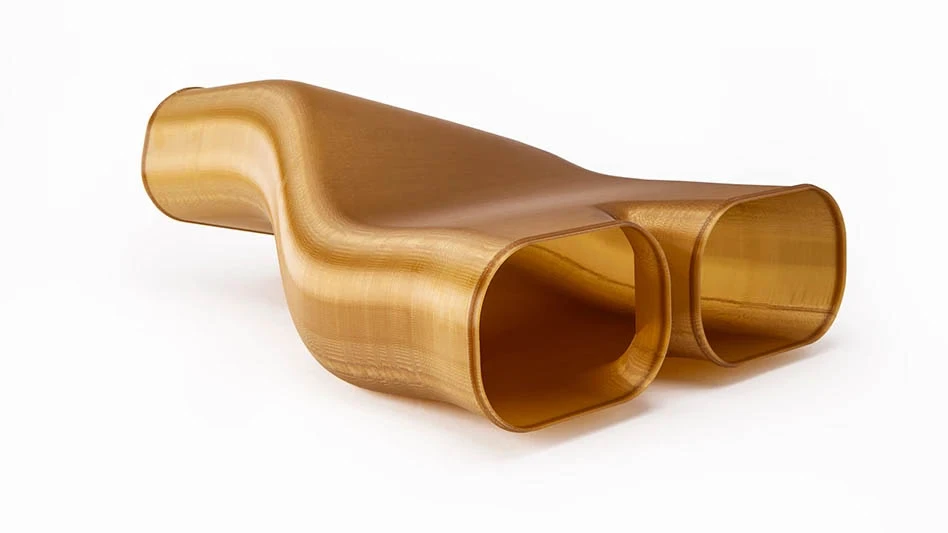 Strict adherence to a one-and-done manufacturing philosophy propelled aerospace manufacturing start-up Gray Manufacturing Technologies (GMT) into a strong $250,000 backlog after its first eight months of operation. This strategy relies on a majority of parts being manufactured using 5-axis CNC equipment and Dynamic Motion technology (Mastercam CAD/CAM software from CNC Software Inc., Tolland, Connecticut). The manufacturing concepts and funding for the new venture came from the motor sports industry where fast starts are mandatory.
Strict adherence to a one-and-done manufacturing philosophy propelled aerospace manufacturing start-up Gray Manufacturing Technologies (GMT) into a strong $250,000 backlog after its first eight months of operation. This strategy relies on a majority of parts being manufactured using 5-axis CNC equipment and Dynamic Motion technology (Mastercam CAD/CAM software from CNC Software Inc., Tolland, Connecticut). The manufacturing concepts and funding for the new venture came from the motor sports industry where fast starts are mandatory.
While at Gray Motorsports, manufacturing engineer Jerry Soots developed advanced manufacturing processes that allowed for fast turns on complex auto-racing parts. The value of this work was not lost on the owner Johnny Gray. After a brief stay, Soots left to take a high-level job back in aerospace manufacturing where he came from. However, Gray was determined not to let such valuable talent get away. He enticed Soots to come back to start up and manage the new aerospace business.
Once in a lifetime
Soots had always wondered what it would be like to run his own manufacturing business with the equipment of his choice and processes that would implement his vision of one-and-done manufacturing. It was a once-in-a-lifetime opportunity, and the trust and financial backing that Gray gave him made it possible.
In the early stages, Gray and Soots exchanged ideas about which industry to target for their company’s manufacturing capabilities. The two considered motor sports and medical devices but eventually chose aerospace, because of Soots’ experience in that arena and because of projections for continued strong aircraft orders. Once they had committed to aerospace, it didn’t take long for Soots to bring in a substantial number of orders.
 During the first few months, Soots worked out of the Gray Motor Sports’ shop while Gray renovated a large building and equipped it with advanced 5-axis CNC machines. Then Gray told Soots to do his thing, reporting back periodically to let him know how the millions of dollars he had invested were doing.
During the first few months, Soots worked out of the Gray Motor Sports’ shop while Gray renovated a large building and equipped it with advanced 5-axis CNC machines. Then Gray told Soots to do his thing, reporting back periodically to let him know how the millions of dollars he had invested were doing.
One-and-done mentality
“We try to take on a ‘one and done’ mentality,” Soots says. “Our five 5-axis machines allow us to reduce operations and eliminate operator intervention. Using as few setups as possible, we reduce manufacturing cycles, and we can tie all the geometric mapping tools and datum structures of the part together, so that our parts are as dimensionally correct or as perfect as we can make them.”
To take full advantage of his 5-axis equipment, Soots decided to upgrade from rudimentary CAD/CAM software he had been using in motorsports and implement Mastercam CAD/CAM software. He used this software at his aerospace job and knew that it was user-friendly, with powerful features that would allow high levels of programming and manufacturing productivity. Three new 5-axis machining centers and a lathe with live tooling were delivered and installed at the end of 2013. Within a few weeks, Jimmy Wakeford, owner of Barefoot CNC, the local Mastercam reseller, coordinated post-processor development with In-House Solutions to ensure that all the CNC equipment behaved similarly. This was in keeping with the company’s belief that everything should be standardized as much as possible.
Optimizing 5-axis processes
By early February 2014, GMT had 12 machinists on staff. Three are proficient in Mastercam programming, and Soots does some as well. A number of others are proficient in the machine tools’ software, which they use to create simple programs at the machines. This allows the team to keep the stream of manufactured parts moving with minimal interruptions.
Many of the parts the company manufactures are made of titanium. Difficult to machine at high speeds, titanium leads to high levels of tool wear and breakage when machinists use conventional tool paths.
Soots says, “I have worked in many different venues where we were machining titanium at 160 surface feet per minute. Now with the Dynamic Motion tool paths that are integrated with Mastercam, we are machining titanium at 450 feet per minute and I can get two hours of run time out of my tooling.
“Mastercam’s Dynamic Motion technology does a really good job of keeping depth of cut for tool paths constant. Radial stresses are minimal and this helps us accurately project tool costs for a specific job. For the parts we make out of titanium, the average cycle time is about eight hours and the tools that we use are about $250 to $300. So by making parts faster and using fewer tools per part, we are significantly improving per part profitability.”
Dynamic Motion technology has also reduced the time it takes to program a part, Soots explains.
“You can just select your parts, set your containment boundaries, then select the axial and radial depths of cut at the feeds and speeds that you want and, bam, in less than five minutes you have a roughing tool path. Five years ago it would have taken significantly longer,” Soot says.
While the machines are running their long cycles, the programmer/machinists can write a lot of programs for the 5-axis equipment, Soots adds. They can use these high-speed machining strategies with confidence because they use the software’s 3D simulation to detect interferences. They also automatically compare the simulation to the actual CAD model to ensure that the program will make a good part.
For the specialized task of creating programs for manufacturing blisks, GMT has been evaluating Mastercam’s Blade Expert software. This software automatically generates programs for many different multi-blade configurations. To program, operators click on a small number of blade features and enter requested parameters. Soots says that the blisk programs can be created in a fraction of the time that conventional programming would allow, and machine cycles are significantly faster.
.jpg)
Fast forward
Programming and machining efficiency has allowed GMT to grow quickly. In December 2013, the company shipped 225 5-axis parts based on 12 part numbers. In January, deliveries shot up to 700 parts based on 40 part numbers.
Soots spends a lot of his time looking for more quality hires. A highly skilled programming and manufacturing process consultant, Jeremy Herron of DBS Solutions, fills in gaps when there are surges in work or when highly specialized manufacturing expertise is required. However, in the long run, the company knows that on-going success will require closing the skills gap to ensure access to trained workers.
Mastercam CNC Software Inc.
www.mastercam.com
Gray Manufacturing Technologies
gray-mfg.com

Explore the January February 2015 Issue
Check out more from this issue and find your next story to read.
Latest from Aerospace Manufacturing and Design
- NASA selects instruments for Artemis lunar terrain vehicle
- Twin-cutter boring head
- Bell awarded funding for X-plane build phase of SPRINT program
- Shaft coupling clamps
- #46 Lunch + Learn Podcast with SMW Autoblok
- Gleason Corp. acquires the Intra Group of Companies
- Thread milling cutter reduces cutting pressure, vibration
- Malaysia Aviation Group orders 20 more Airbus A330neo widebodies





